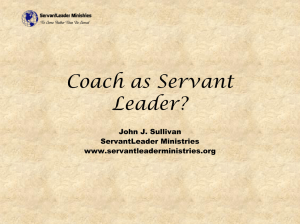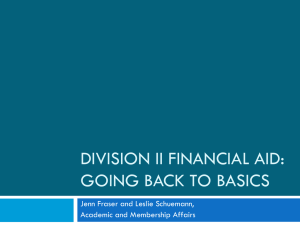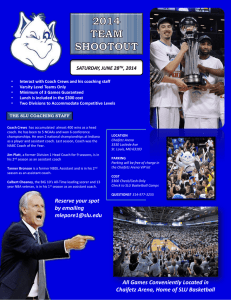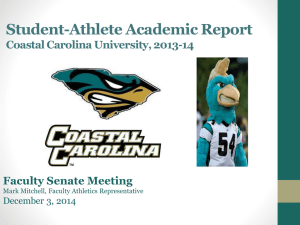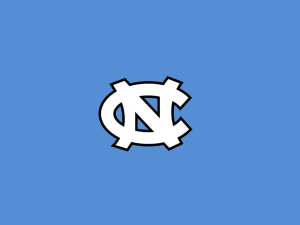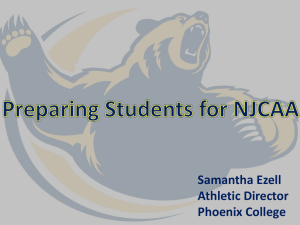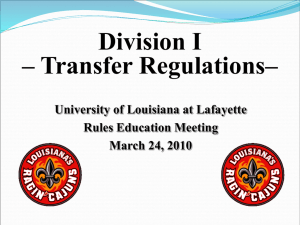NCAA Division I Introduction to Financial Aid – Fundamental
advertisement
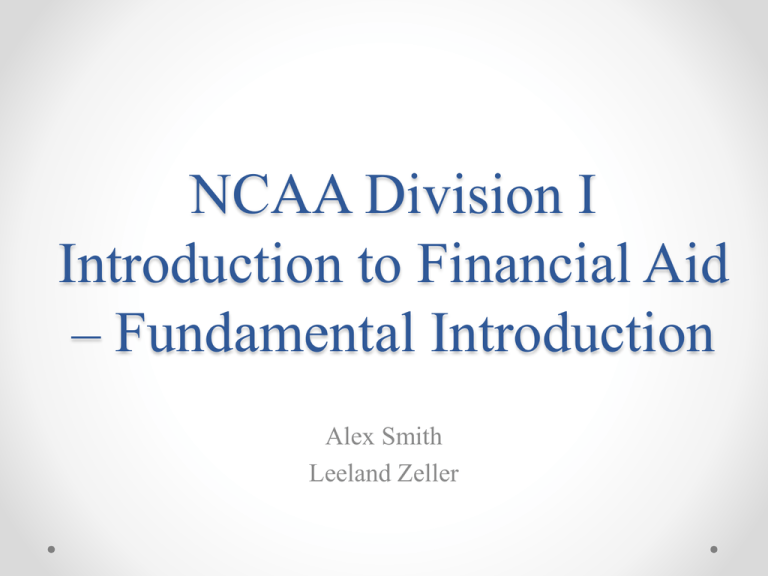
NCAA Division I Introduction to Financial Aid – Fundamental Introduction Alex Smith Leeland Zeller Learning Objectives Identify fundamental financial aid legislation and effectively explain the legislation to institutional constituents; Apply specific financial aid legislation to basic factual scenarios; and Analyze potential financial aid issues. Topic Areas Eligibility for financial aid. Permissible types of financial aid. Exempt institutional aid. Period of the award. Increase/reduction/cancellation of athletics aid. Elements of athletics aid. Team financial aid limits (head count and equivalency). Eligibility for Financial Aid Eligibility for Financial Aid May provide aid to a student-athlete who was initially enrolled full time during that term. Undergraduate with eligibility remaining under NCAA Bylaw 14.2 (five-year rule); or Graduate student eligible under Bylaw 14.1.8. Exceptions to full-time enrollment. Final semester/quarter. Exhausted eligibility student-athlete (within five-year period) who is carrying all available courses needed for graduation. Former student-athlete (beyond five-year period). Permissible Institutional Aid Funds administered by the institution: Scholarships. Grants. Tuition waivers. Employee dependent tuition benefits. Loans. Aid from government or private sources, if the institution: Selects recipient or determines amount of aid; or Provides matching or supplementary funds for a previously determined recipient. Other Permissible Aid Parents and legal guardians. Aid unrelated to athletics ability. Established and continuing outside program (Bylaw 15.2.6.3). Donor may not restrict recipient’s choice of institution. No direct connection between donor and student-athlete’s institution. Not from an outside sports team or organization to studentathlete who is or was a member of the team or organization. U.S. Olympic Committee. Drop-In 1 • Soccer coach drops in with a couple of concerns: o Goalie has dropped to part time a few weeks into the spring semester and coach is concerned that athletics aid needs to be taken away for the remainder of the term. o Prospective student-athlete has received a home town award as an area soccer player with the best overall high school grade-point average and coach is concerned that she can’t accept it because it’s only open to athletes. Drop-In 1 • Soccer coach drops in with a couple of concerns: o Goalie has dropped to part time a few weeks into the spring semester and coach is concerned that athletics aid needs to be taken away for the remainder of the term. • Aid does not need to be taken away. If the SA initially enrolled in a minimum full-time program of studies, the individual is eligible for financial aid even if he or she drops to part time (Bylaw 15.01.5). Drop-In 1 • Soccer coach drops in with a couple of concerns: o Prospective student-athlete has received a home town award as an area soccer player with the best overall high school gradepoint average and coach is concerned that she can’t accept it because it’s only open to athletes. • May accept if meets 15.2.6.3 o Established and ongoing program to aid students; o Choice of institutions not restricted; and o No direct connection between donor and student-athlete’s institution. o Not provided by an outside sports team or organization that conducts a competitive sports program to an individual who is or has been a member of that team or organization. Requirements for Awarding Financial Aid Period of the Award One academic year up to remainder of the five-year period of eligibility. When student-athlete receives any benefits as part of grant-inaid or first day of class or practice, whichever is earlier. One year grants-in-aid must be awarded in equal amounts for each term of the academic year. The summer term is a separate award from the regular academic year award. Bylaws 15.02.7, 15.3.3.1, 15.3.3.2 Exceptions to One-Year Period Midyear enrollment. Final semester/quarter. Applicable if student-athlete’s first full-time term of attendance at the certifying institution occurs after the first term of the academic year. Student-athlete must meet requirements of the final semester/quarter exception. Graduated during previous academic year (including summer) and will exhaust eligibility during the following fall term. Exceptions to One-Year Period (Continued) One-time exception. Student-athlete has been enrolled full time at certifying institution for at least one regular academic term; and Student-athlete has not previously received athletics aid from the certifying institution. Eligibility exhausted/medical noncounter. Agreement must specify nonathletically related conditions (e.g., academic requirements) for renewal. Summer Aid List of requirements per Bylaw 15.2.8. Separate award, but no written statement required (Bylaw 15.3.3.2.1). Summer prior to initial full-time enrollment. Summer coursework may not be used to complete initial-eligibility or continuingeligibility (transfer eligibility, progress toward degree) requirements during initial year of enrollment. Continuing student-athletes. Awarded in proportion to aid during prior academic year, unless: o Exhausted eligibility and enrolled in degree-applicable courses. First-time recipient in next academic year. o May receive summer aid in proportion to athletics aid awarded for next academic year. Increase or Reduction of Aid Increase permitted for any reason at any time. Decrease not permitted from the time the student-athlete signs until the conclusion of the period of the award. Except: o Ineligible. o Fraud. o Serious misconduct. o Voluntary withdrawal. o Nonathletically related conditions. Increase or Reduction of Aid Decrease NOT permitted during the period of the award: Based on the student-athlete’s athletics ability. Because of an injury, illness or physical or mental medical condition. For any other athletics reason. Hearing opportunity. Release of Obligation • Before becoming a counter for an academic year pursuant to a one-year grant-in-aid. • On own initiative, student-athlete may release institution from obligation to provide athletically related financial aid. • If awarded aid unrelated to athletics equal or greater than signed award of athletically related aid. Drop-In 2 • Swimming coach wants to see about doing the following: o o o Get full summer covered for a swimmer who is currently a .25, but who coach plans to increase to a full scholarship next academic year. Increase aid for the remainder of the year for most improved diver whose father just lost his job. Cancel aid for remainder of the year for two swimmers – one for constant disregard for team rules and one for requesting permission to contact other schools about transferring. Drop-In 2 • Swimming coach wants to see about doing the following: o Get full summer covered for a swimmer who is currently a .25, but who coach plans to increase to a full scholarship next academic year. • Summer aid must be in proportion to aid received for the previous academic year. May look to SAF. Drop-In 2 • Swimming coach wants to see about doing the following: o Increase aid for the remainder of the year for most improved diver whose father just lost his job. • Increase permitted for any reason at any time. Drop-In 2 • Swimming coach wants to see about doing the following: o Cancel aid for remainder of the year for two swimmers – one for constant disregard for team rules and one for requesting permission to contact other schools about transferring. • • Swimmer One - Absent nonathletically related conditions in financial aid agreement regarding violation of team rules as reason for reduction or cancellation, may not cancel. Swimmer Two – May not cancel. Request for permission to contact does not constitute a voluntary withdrawal. Elements of Financial Aid Tuition and Fees Tuition and fees. Actual cost of tuition. o May only pay tuition to attend the awarding institution. o Summer school is a separate award. Required institutional fees. o May pay course-related fees for a course in which the studentathlete is enrolled if institution pays these same fees for others in the course who receive fees as part of a scholarship. o May not pay fees for services offered on an optional basis to the student-body in general. Impermissible Fees Fees for prospective student-athletes. Impermissible to waive, pay in advance or guarantee payment of the following fees, unless consistent with institutional policy of all prospective student-grantees. o o o o o o Application processing fee. Orientation-counseling tests fee required of all students. Preadmission academic testing fee. Advance tuition payment or room deposit. Damage deposits for dormitory rooms. ROTC deposits for military equipment. Permissible to rebate first four fees following enrollment. Room Allowance Off-campus room stipend. An institution may provide an amount equal to: o The institution’s official on-campus room allowance as listed in its catalog; o The weighted average of the room costs for all students living in on-campus facilities; or o The cost of room as calculated based on its policies and procedures for calculating cost of attendance for all students. Board Allowance Off-campus board stipend. An institution may provide an amount equal to: o The maximum meal plan that is available to all students; or, o The cost of meals as calculated based on its policies and procedures for calculating cost of attendance for all students. o Excluding training table. NCAA Proposal No. 2013-28 effective August 1, 2014 Books Actual cost of required course-related books. No limit on the dollar amount that may be provided. Each book must be required for a course in which the student-athlete is enrolled. May provide cash equal to the actual cost of the books. Books count as $800 in the denominator for purposes of calculating a student-athlete’s equivalency. Numerator reflects portion of year for which the studentathlete received books (e.g., $400 for one semester). Must include value of books in the summer grant-in-aid. No Retroactive Aid • Institutional financial aid awarded to an enrolled studentathlete after the first day of classes in any term may not exceed the remaining room and board charges and educational expenses for that term and may not be made retroactive to the beginning of that term. Drop-In 3 • Wrestling coach has a couple of questions: o o Has two wrestlers. One he signed for this year who just received an initial-eligibility waiver for aid and practice. The other he wants to sign now. Can he cover aid for the whole term for both of them? Can I provide all my wrestlers required and suggested books? How? Drop-In 3 • Wrestling coach has a couple of questions: o Has two wrestlers. One he signed for this year who just received an initial-eligibility waiver for aid and practice. The other he wants to sign now. Can he cover aid for the whole term for both of them? • Wrestler One - May cover full term as agreement signed prior to term and retroactive aid not applicable. • Wrestler Two – May not provide retroactive aid. Aid may only cover remainder of term. Drop-In 3 • Wrestling coach has a couple of questions: o Can I provide all my wrestlers required and suggested books? How? • May provide all wrestlers with suggested books per 16.3.1.1 (academic counseling/support services). May also look to SAF • Required books may only be provided as part of financial aid. Athletics aid to cover would make all wrestlers counters. Individual and Team Limits Countable Aid Individual limit. Athletics aid up to the full grant-in-aid. Nonathletics aid up to cost of attendance. Team limit. Athletics aid counts toward the team limit. Once a counter, all institutional aid becomes countable (except exempted institutional aid). A student-athlete (other than a recruited football or basketball student-athlete) does not become a counter based on receipt of institutional aid granted without regard to athletics ability. Exempted Aid Certain types of institutional aid may be exempt from counting toward the institutional (team) limit for a studentathlete who is otherwise a counter. Examples include honorary academic awards, federal needbased grants (e.g., SEOG), state need-based grants, state meritbased grants, etc. Complete list is designated in Bylaw 15.02.4.3. Certain government grants may be exempt from counting toward a student-athlete’s cost of attendance. Examples include AmeriCorps, Post-9/11 G.I. Bill. Complete list is designated in Bylaw 15.02.4.3. Head Count and Equivalency Sports Head count sports have academic year limits for the total number of counters. Equivalency sports -- Aid expressed as a fraction. Amount of aid received by the student-athlete (up to a full grant-in-aid) as the numerator. Full grant-in-aid as the denominator. Actual or average method. o o Actual method involves a calculation based on a studentathlete’s actual grant-in-aid. Average method involves a calculation based on the average value of a grant-in-aid at the institution. Equivalencies: Use of Actual and Average Methods • May use actual or average cost of any or all of the elements (other than books), provided the same method is used in the numerator and denominator. • Either method (or different combinations of methods among elements) may be used for each student-athlete on the same team or for separate teams. • It is not permissible to average the value of in-state and out-of-state tuition and fees to determine an average cost for tuition and fees. Equivalency Exceptions Academic Honor Awards – Based on high school record. Exempt from equivalency computation provided recipient meets criteria in Bylaw 15.5.3.2.2.1. Additional criteria, if any, may not include athletics participation. Academic Honor Awards – Transfer students. Based solely on cumulative academic record at all collegiate institutions previously attended or high school record and cumulative collegiate record. Exempt from equivalency computation provided recipient achieved a cumulative transferable grade-point average of at least 3.000 (based on a maximum of 4.000). Equivalency Exceptions (Continued) Institutional academic scholarships. Based solely on the recipient’s record at the certifying institution. o o o Awarded independent of athletics. Awarded consistent with pattern of all such awards made by the institution. Exempt from equivalency computation provided recipient has completed at least one academic year at the certifying institution and achieved a cumulative grade-point average of at least 3.000 (on a 4.000 scale) at the certifying institution. Drop-In 4 Track and Field coach wants to provide a partial athletics scholarship to a prospective student-athlete, but is aware of several other potential aid options and wants to determine impact on overall equivalency. o o o Academic award for students with above a 2.5 high school grade-point average. Institutional work in the central and athletics department mail room. Out of state tuition waiver for any student admitted to institution from list of specific states. Drop-In 4 Track and Field coach wants to provide a partial athletics scholarship to a prospective student-athlete, but is aware of several other potential aid options and wants to determine impact on overall equivalency. o Academic award for students with above a 2.5 high school grade-point average. • Countable in team limits unless meets academic criteria to exclude (top 10 percent of high school graduating class, high school GPA of at least 3.50 or 105 ACT/1200 SAT) Drop-In 4 Track and Field coach wants to provide a partial athletics scholarship to a prospective student-athlete, but is aware of several other potential aid options and wants to determine impact on overall equivalency. o Institutional work in the central and athletics department mail room. • On or off campus work is not counted in team limits if meets 15.2.7 (e.g., compensated for work actually performed; at going rate in locality for similar services). Drop-In 4 Track and Field coach wants to provide a partial athletics scholarship to a prospective student-athlete, but is aware of several other potential aid options and wants to determine impact on overall equivalency. o Out of state tuition waiver for any student admitted to institution from list of specific states. • Institutional aid that would need to be counted in team limits. The Next Drop-In: Resources • Manual. • LSDBi. • Conference Office. Still have a question? • RSRO. Questions?

